MEZCAL
MEZCAL from Oaxaca
The name mezcal has its roots in one of the ancient native languages of the area and translates as ‘agave (also known as maguey) cooked’. Although pre-Hispanic Oaxaqueños used maguey to make pulque (an undistilled alcoholic beverage), it seems that the real advances in mezcal production occurred when the Spanish arrived in Oaxaca; by bringing with them their knowledge of distillation processes.
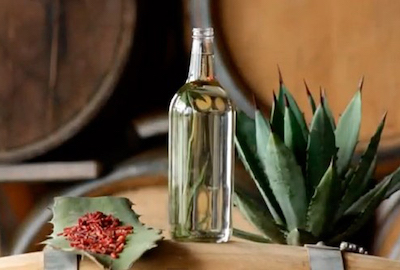
Mezcal is a rich, handcrafted flavored drink that requires considerable attention to be produced. Mezcal production today remains more or less as it was when the Spanish arrived hundreds of years ago. Each “recipe” is transmitted from generation to generation within the families that care about its production; Because each family has its own approach to mezcal production, there are an enormous number of different flavors.
It is also in this way that the rich diversity of flavors and traditions are preserved for all to enjoy. Mezcal is normally served with white salt or worm salt (salt mixed with a cooked larva and ground chili), lemon or orange.
There are different types of maguey, and each produces a different version of mezcal; one of the best known, although it does not correspond exactly to the traditional definition of mezcal, is tequila. Simply put, tequila is actually a type of mezcal. The production of mezcal is regulated by the Official Mexican Standard NOM-070-SCFI-1994.
History of MEZCAL
In excavations started in 1994 by anthropologists from the National Autonomous University of Mexico in the town of Oaxaca, evidence was obtained to determine that mezcal was formerly obtained from the maguey plant (generally known for its use for making pulque).
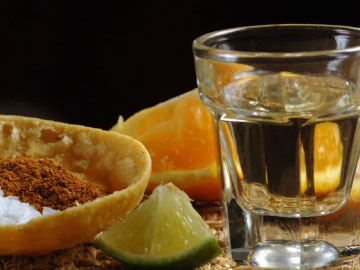
In order to expand their research, university scientists developed, in 1998, the project La ruta del mezcal, through which they toured indigenous communities to identify the places where mezcal is produced in the artisanal way; they realized that it was still distilled in clay pots, and that they were dated around 400 BC.
Currently, mezcal has a Denomination of Origin, which protects the production of this drink in the states of Oaxaca, Durango, Guanajuato, Guerrero, Michoacán, San Luis Potosí, Puebla, Tamaulipas and Zacatecas. In 2018, the incorporation of the state of Aguascalientes, Morelos and the State of Mexico was published in the Official Gazette of the Federation. The states mentioned are the only regions in the world today that have the designation of origin called Mezcal.
Another approach refers that it is a drink that emerged during the colony, with the arrival of the stills. A curious fact is that many of the artisanal mezcals are distilled in what is known as the “Filipino alembic”. These stills came on Philippine ships, and coconut and palm beverages were distilled.
These Philippine ships reached the western coast of Mexico and spread their use. However, when entering the geography, coconut and palm were replaced by agave mead, and from there mezcal was obtained.
Types of MEZCAL
It is possible to find a great variety of mezcals according to the type of distillation, according to the variety of agave or according to the fruits or herbs that are added to it; among them, “gusanito” (worm), “pechuga”, white, miner, lemon verbena, scorpion, coffee cream and others.
When the plant reaches maturity (six to eight years), it is harvested and the leaves are cut, leaving only the heart or pineapple (it is so called because its shape is very similar to a pineapple), which is cooked and then it is ground.
Not all maguey species are acceptable: NOM 070 stipulates that they should be used exclusively: Agave angustifolia (espadín maguey), Agave esperima (maguey de cerro or raw maguey or ash maguey), Agave weberi (maguey de mezcal), Agave potatorum ( maguey de mezcal) and Agave salmiana. NOM 070 recognizes more than 20 varieties of agave to produce mezcal.
Each variety generates a mezcal with a different flavor. Mezcals are classified as ancestral, which are those that their elaboration meets certain requirements such as grinding with a mallet or taona and distilled in clay pots and the artisan class, which can be grinded with brush cutters and their distillation is in copper stills.
Types of Agave
Mezcal, like wine, is part of a plant (Agave in mezcal, Vitis vinífera in wine) but they have several types of it, mezcal can be made with approximately 14 different types of agave, there are wild agaves that, as their name suggests, these are agaves that are found in wild environments and not in fields like other agaves that have already been “domesticated”.
An example of these is the “Espadín” from Oaxaca, these types of mezcal are higher in prices because the producer uses more raw material to obtain the final product, therefore it is a unique product in quality, in addition, the taste is very different from a reposado or aged mezcal, these mezcals do not go through the barrel due to the high cost of production and because there is no point in assembling the complex flavors that they already entail. Sometimes they mix more than one type of agave in a bottle. These are called “assemblage” since it is the set of two or more types of mezcal in a bottle.
Types of wild agave:
Tobalá
Small wild agave with thick leaf also called “Papalometl”, these agaves give a mild mezcal in attack and easy to taste, excellent for people who are entering the world of mezcal, they can be found mainly in the Mixteca and in some places in Puebla.
Cuishe
Elongated and thin-leaf wild agave, these agaves once clean to be baked are elongated in shape very similar to the trunk of a tree, they give a mezcal with a strong flavor and incredible aromas where its aroma of maguey and the same honey water, these mezcals have complex flavors but excellent aftertastes where we can obtain different flavors depending on whether it was the first type (madrecuixe, bicuixe). They abound mainly in Oaxaca.
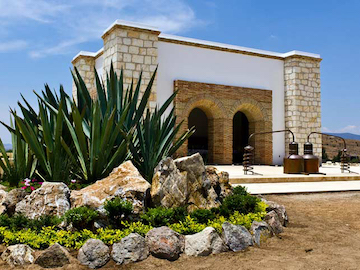
Coyote
Small agave with black spines and thick reddish leaves, this type of agaves gives a unique mezcal in flavor and aroma, strong flavor and lasting intensity, excellent for people who are in love with mezcal to include in their personal cellar. We can find them in the Mixteca, in Michoacán and Puebla.
Tepezate
Elongated leaf small agave, these agaves give a mezcal with a strong flavor and long-lasting aroma, where the alcoholic and intense flavors of the maguey abound, excellent mezcal to taste, we can find it mainly in Oaxaca.
Papalote
Small thick leaf agave, it may have other names depending on the region, also called “Cupreata” these agaves are slightly sweeter and softer compared to others, they give a mixture of rich and light flavors where the sweetness of the agave abounds. , we can find them in Puebla and Mixtec areas.
Cenizo
small thick leaf agave, from this type of agaves we obtain a mezcal rich in aroma and strong flavors, this type is found in the areas of Durango and Zacatecas, it can even be used to make Pulque.
Estoquillo
Small agave with an elongated leaf, we obtain a mezcal with strong flavors and long-lasting aromas, a balanced mezcal but with a marked intensity, mainly sweet flavors due to its large amounts of sugars, we can find it mostly in Tamaulipas.
Mexican
Elongated and large agave, we obtain a mezcal balanced in aromas and strong flavors, this agave is mainly found on the top of the mountains and due to its beauty it bears the name “Mexican” it can be found in the Mixteca but mainly in Oaxaca.
Elaboration Process of MEZCAL
The production of mezcal is artisanal and therefore varies from region to region. However, a more or less homogeneous process is determined that follows the following stages:
Cultivation and harvest
The process begins with the cultivation of the maguey. The sowing takes place in the most diverse lands, and its cultivation is within what is now known as organic agriculture, since no artificial products are used in it. The agave takes between 8 and 10 years to be “at its peak.”
Selection of the most suitable raw material
For generations, mezcal agaves have been selected from wild plants and have been improved. The grower has to verify its good condition so that they cut it.
To cut the “pineapples”
Later, the leaves and roots are cut until the center of the maguey is exposed, this form of the maguey is commonly known as “pineapple”.
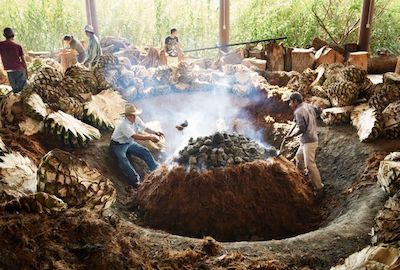
Transfer to the palenque
The transfer of the pineapples to the palenques or mezcal factories is done in carts pulled by oxen or cargo trucks, depending on the amount and type of land where the collection has been made. The palenques are generally located near the plantations where they find the necessary resources to process the pineapples such as firewood and water. It should be ensured that they are roofed and that they have a cement floor.
Cooking
Then comes the cooking of the pineapples. Before putting them in the floor oven, the pineapples are chopped with blows of the ax to facilitate cooking. The oven can be of two types and varies depending on its use. We generally see them lined with refractory stone, they are located in places where mezcal is produced in large quantities, they are mainly found in the municipalities of Tlacolula, Yautepec and Ejutla.
The oven had to be preheated until the stones show a red-hot color, then the pineapples are placed, covered with bagasse and then with earth. Baking lasts approximately three days to achieve full cooking. At the end of this phase, the agave changes from white to caramel, which is an indication of a good cooking, since it has been achieved “that the carbohydrates or starches contained in the pineapples are transformed into sugars.
Grinding
It is generally carried out in an Egyptian mill, consisting of a cement well with a central post and a stone wheel that turns by the traction of a beast of burden controlled by a person. The cooked agave is also crumbled and crushed to obtain the musts that will be used for fermentation.
Fermentation
The musts are transported to oak or oak wood vats that can hold up to two thousand liters. The fermentation process has two fundamental elements: water and temperature. The time it takes to ferment will depend on the latter; that goes from three to five days. Natural fermentation allows microorganisms to act freely and break down carbohydrates to convert them into ethyl alcohol.
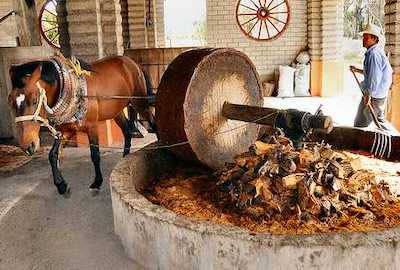
You can help the process without altering it, alternately pouring hot and cold water to support the microorganisms. However, it has been observed that some mezcaleros use ammonium sulfate to shorten fermentation times to increase their production. This form of fermentation is called accelerated, but “mezcaleros say that the taste of mezcal changes if any substance is added to accelerate fermentation.
At the end of the fermentation process, the cooked musts called “tepache” are passed to the alembics to carry out the distillation. This is done with bagasse and with equipment made of copper, clay pots, reed or quiote; depending on the region, customs or productive capacity. The mixture is heated in the alembic, evaporates and slowly condenses through a coil that deposits its contents in a container.
Packing
It is the last phase of the process, for this the mezcaleros standardize the product through various methods such as homogenization and stabilization of the mezcal. First there is the adjustment of the alcoholic degree, which according to the NOM of mezcal should be between 36 and 55% alcohol by volume.
This is done according to each producer. Some mezcaleros use a reed pipette and a small container where they pour the mezcal, they observe the formation of bubbles that is made and depending on the size of these “pearls” it is determined whether the mezcal is of good quality or not. Other modern means for the homogenization of the product is through laboratory tests that allow the distillate to be given the same graduation through various methods of dilution, filtration and settling.
Thus, “a pure, persistent, bright and full-bodied young drink” can be obtained, ready to be packaged according to the producers’ brands. Packing plants have diverse characteristics, from manual to semi-automatic packaging.
These help to carry out an adequate quality control of the mezcal; However, there is also bulk mezcal, which is more for local consumption, or also small producers that do not have registered trademarks and pack their mezcal in glass or black clay containers completely by hand.
Difference between MEZCAL and TEQUILA
A variety of mezcal is Tequila, a drink that gets its name from the town where it is produced (Tequila, a Magical Town in Jalisco) and whose process has been fully industrialized, a situation that generates the great difference between tequila and artisanal mezcal. Unlike mezcal, Tequila can only be made from the Tequilana Weber agave, a blue variety, while in mezcal all the agave species found within the area with designation of origin can be used as raw material mezcal.
Place of Origin
In Mexico, different liquors are produced and consumed that make the residents proud and give identity to the regions, and in Oaxaca it is mezcal. Like tequila, mezcal comes from a variety of agave, and its process is completely artisanal. In the vicinity of Oaxaca it is possible to visit factories that guarantee to have a very personal touch in each variety of their drinks.
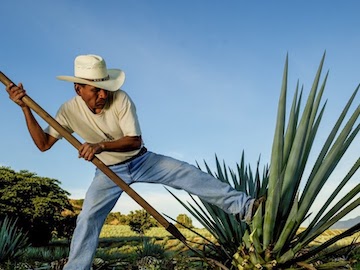
The espadín, arroquense and tobalá agaves are three of the species that, fermented and distilled, produce as many varieties of mezcal. Sprat and arroquense are products of the crop, while tobalá is a wild agave that is the most common in the production of mezcal. Unlike tequila, which is only made with blue agave, mezcal varieties are made with a mix of different agave families.
The peasants wait patiently for the stalk to grow, as it will take about seven years for the plant to mature. The process begins when the farmer separates the pineapple from the stems, leaves and roots that surround it. Once the pineapples are obtained, they are cooked and then ground. The resulting bagasse is left to settle in large, fragrant vats.
Already here, the process requires calm and patience to wait for the bagasse to ferment; at this point, the liquid passes into the stills. This is the moment in which the artisan develops his particular way of endowing the future mezcal with its characteristic flavor. In the preparation of the authentic tobalá mezcal, it is essential that the process takes place in clay pots.
Finally, it should be noted that there are different varieties or types of Oaxacan mezcal: reposado, añejo, minero, “pechuga”, and “gusanito”.
Flavor
Mezcal has a strong aromatic flavor of sweet, earthy and smoky citrus notes. Tequila too, but with a tendency to be neutral.
Agave species (Maguey)
Mezcal is made from Agave vivipara variety “Haw”, and has more sugars and is larger. In Zacatecas, both blue agave (region of the canyons of Juchipila, Jalpa, etc.) and Agave salmiana (southeast region, Pinos and Villa Hidalgo) are used. For tequila, only Tequilana Weber agave, a blue variety, is used.
More Tourist Attractions in OAXACA
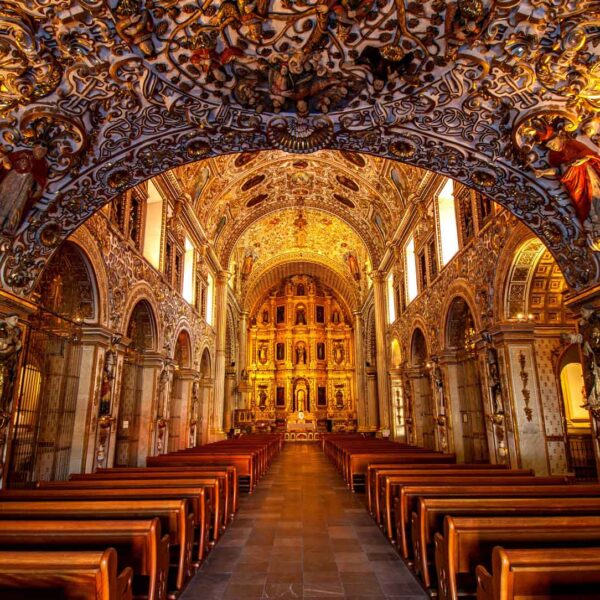
Santo Domingo Cultural Center
The Santo Domingo Cultural Center is a cultural complex that is located in what was one of the most important convents in the colony. It is a large convent in which the Museum of the Cultures of Oaxaca, the Fray Francisco de Burgoa Library and the Ethnobotanical Garden have been established. The Néstor Sánchez Public Newspaper Library is located in a building that is part of the complex but dates from the 19th century.… Read More
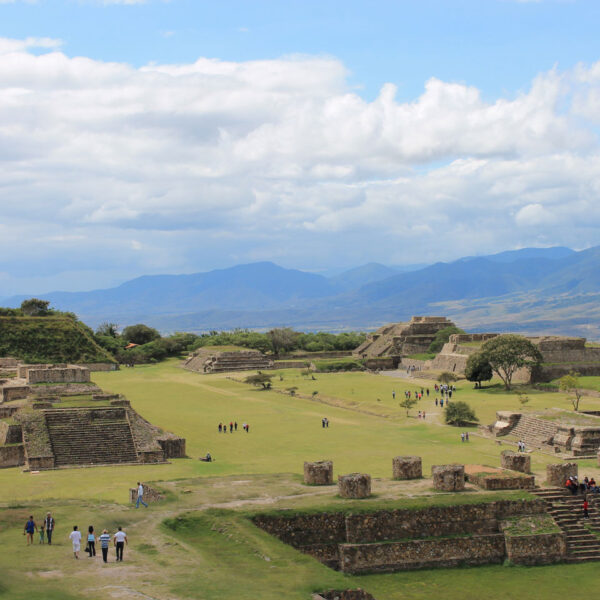
Monte Alban
Monte Alban is the most important archaeological zone of the Oaxacan entity, of unique regional importance due to the religious, political and economic control that the Zapotec state exercised over the population of the Valley of Oaxaca for more than thirteen centuries. It has been named by UNESCO Cultural Heritage of Humanity together with the city of Oaxaca on December 11, 1987. The heritage of the Zapotec world reaches us through the magnificent archaeological sites designed in the Valley of Oaxaca. Of these, the city of Monte Albán stands out for its enormous importance as an economic, political and religious hub (it was the first urban complex in Mesoamerica); by its extension, almost as big as the current capital of Oaxaca; and for its long life, started around 500 BC and concluded around 850 AD.… Read More
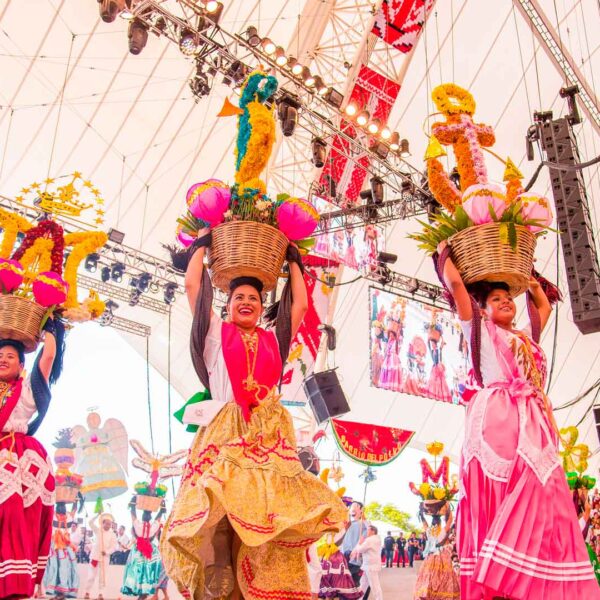
La Guelaguetza
The Guelaguetza is an ancient tradition with pre-Hispanic roots related to agricultural ceremonies of gratitude to the gods for the arrival of the rains and the lifting of the harvest at the end of July and is the largest festival in Oaxaca. La Guelaguetza is a celebration of gratitude for the arrival of the rains and the harvests, in which representatives from all regions of the state gather in the capital to share their culture through dances, crafts and food. La Guelaguetza is celebrated every year on the two Mondays after July 16, except when the first Monday is July 18, Benito Juárez’s death anniversary. Many types of dances also participate, such as the traditional Flor de Piña; where women usually dress in Huipiles representing the different regions of the state, as well as with their pineapple on their shoulders, they comb their hair with beautiful long braids accompanied by their ribbons and can not missing her accessories that is, bracelets, necklaces and earrings of precious colors and her beautiful makeup.… Read More
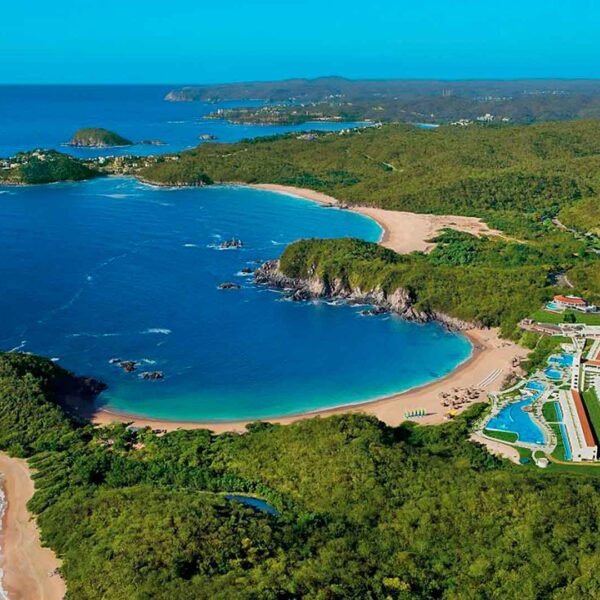
Beaches in Oaxaca
The beaches of the coast of the state of Oaxaca are among the most beautiful and complete in Mexico, thanks to a developing tourist infrastructure and the rich gastronomy of the Pacific. Along the 533 kilometers of coastline, the beaches of Oaxaca offer a wide variety of activities for lovers of water sports: snorkeling, diving, sport fishing, surfing, among others… there is something for everyone!… Read More
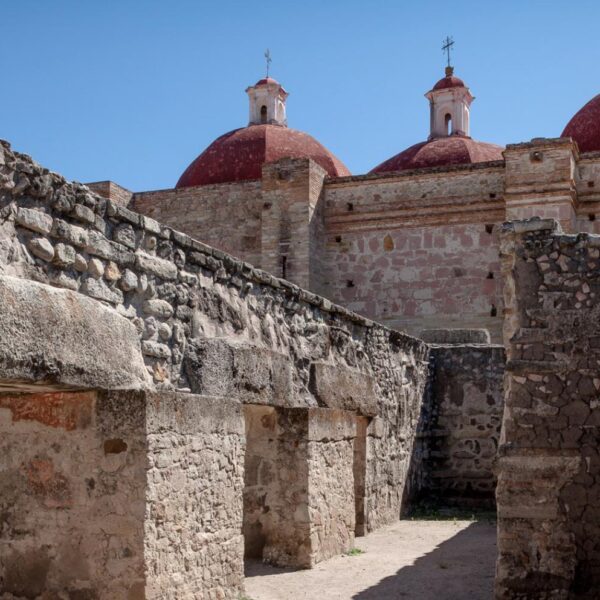
Archaeological Sites in Oaxaca
Oaxaca is famous throughout the world for its archaeological sites and the history they keep. Discover Monte Alban, Mitla, Yagul and more of these remote sites, which have made Oaxaca a World Heritage city, according to Unesco. The original Zapotec and Mixtec peoples of Oaxaca lived in the cities and religious centers of the valley of this city until the time of Spanish colonization. Today, there are still vestiges of these towns and places where you can meet them.… Read More
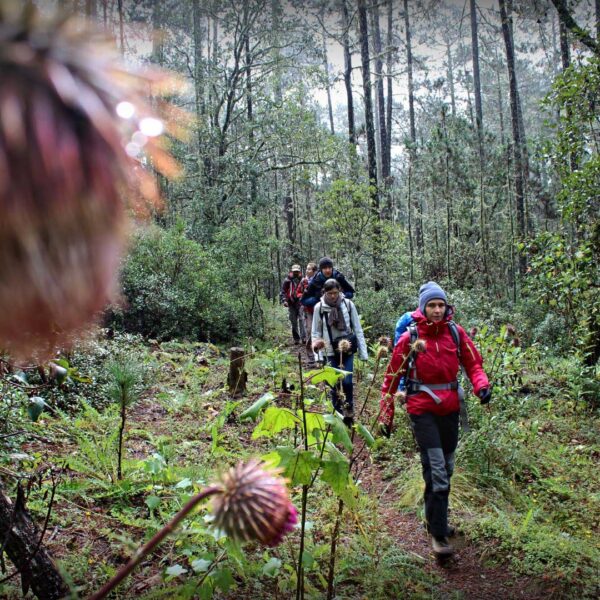
Ecotourism and Adventure in Oaxaca
Oaxaca, located in the southeast of Mexico, is an example of a singular miscegenation that even in the midst of modernity never forgets its origins. In its varied geography, it brings together not only a vast biodiversity, considered among the largest in the world, but also insurmountable cultural and ethnic riches, and the most different and beautiful natural settings. An ideal space for Alternative Tourism, Oaxaca offers activities such as walking, mountain biking, rappelling, climbing, zip-lining, horseback riding, observation of flora and fauna and more, in close contact with nature. The visitor can also witness the various aspects of local life, savor the gastronomy and enjoy the warmth of its people, as well as an offer of accommodation in hotels, ecotourism cabins, local houses or excellent camping areas.… Read More
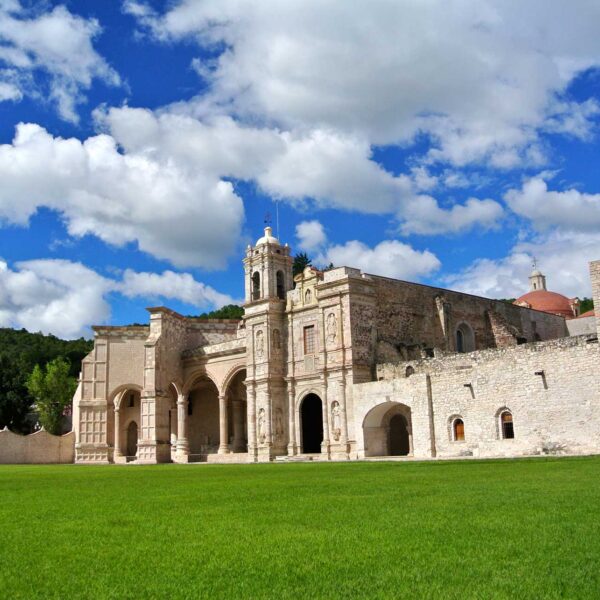
Magical Towns in Oaxaca
In Oaxaca we are proud to have 5 communities that have been awarded the title of Magical Towns of Mexico, a Magical Town is a town that has symbolic attributes, legends, history, transcendent events, everyday life, in short magic that they emanate in each of their socio-cultural manifestations, and that today mean a great opportunity for tourist use. The Magic Towns Program contributes to revalue a group of populations in the country that have always been in the collective imagination of the nation as a whole and that represent fresh and different alternatives for national and foreign visitors.… Read More
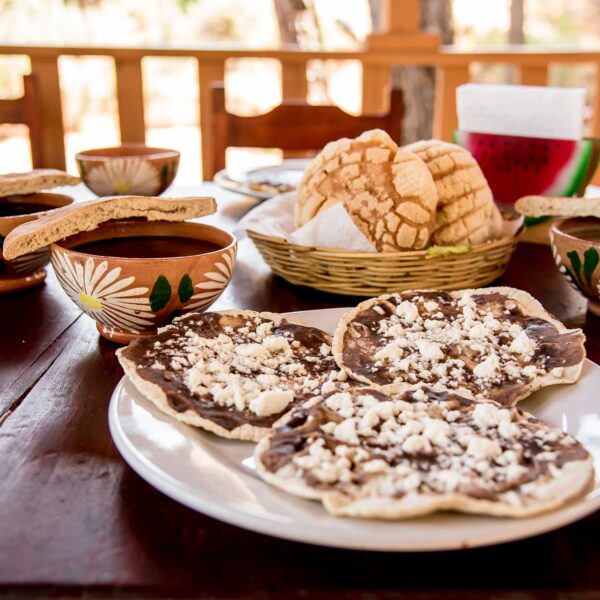
Gastronomy of Oaxaca
The Oaxacan gastronomy takes you on an amazing journey into one of the most outstanding and colorful cuisines in the world. Oaxacan food is among the most varied and delicious in Mexico, UNESCO has declared it Humanity’s Cultural Patrimony. Oaxaca’s gastronomy incorporates elements of pre-Hispanic cuisine, and lively imagination has created combinations that amaze by the color, the aromas and the flavors.
The list of dishes that characterize this cuisine is endless, however, we can mention: Oaxacan Mole in its 7 varieties depending on the type of chili used, Chapulines, (dry roasted, spiced grasshoppers), tlayudas (large tortilla spread with the remaining of the lard and beans), maguey worm sauce, chiles rellenos (stuffed chilies), and of course the famous Oaxacan tamales in banana leaves. Oaxaca cheese is a soft white string cheese, which is similar to mozzarella. It is sold in “ropes” which are wound onto themselves into balls, and eaten cold or lightly melted on quesadillas is considered among the best in the world.… Read More
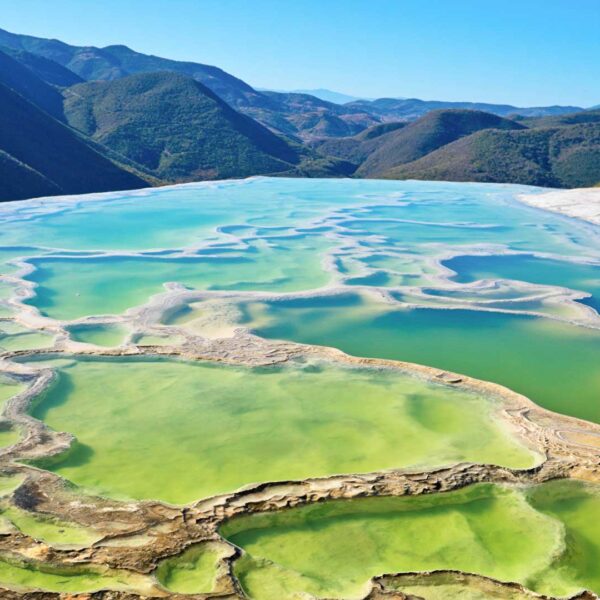
Oaxaca City Surroundings
Oaxaca is a destination that offers a great variety of attractions and tourist charms which leave anyone surprised. When arriving in the city of Oaxaca, the most common is to visit the historic center, the Santo Domingo Temple, the Macedonio Tourist Walk, the gastronomic delights in the Benito Juárez market, the Basilica de la Soledad, among other attractions. And one of the places that you cannot miss is the Monte Alban archaeological zone, which is approximately 30 minutes by car from the historic center. However, there are other places that are also worth knowing and are in the surroundings of the city. For this reason we recommend the following tourist routes.… Read More
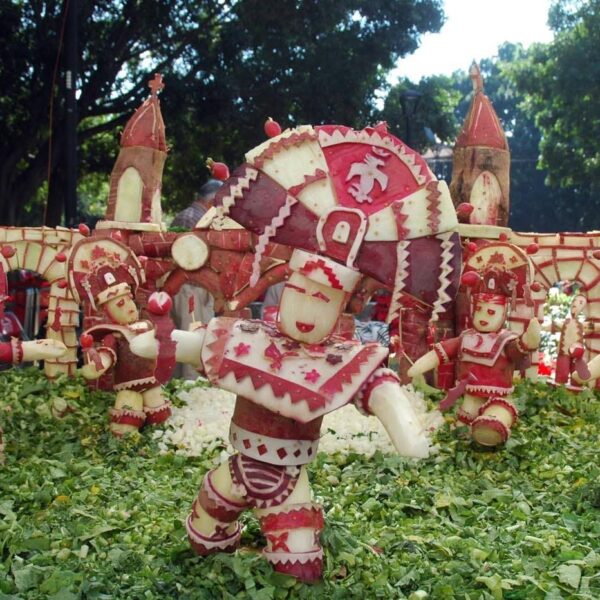
Traditions of Oaxaca
In the state of Oaxaca there are many customs and traditions throughout the year, and within the state, said that they have the same purpose of celebration but with different things, in fact from one region to another or even more from one town to another, the Customs vary for perhaps details but that is what makes them authentic. All the holidays are celebrated, the profane and the religious ones. The festival calendar is extensive due to the diversity of ethnic groups, which they still conserve. Oaxaca has a combination in its traditions of the culture of the ancestors and the current culture, a state that does not lose its customs, adapts them to new times and needs.… Read More
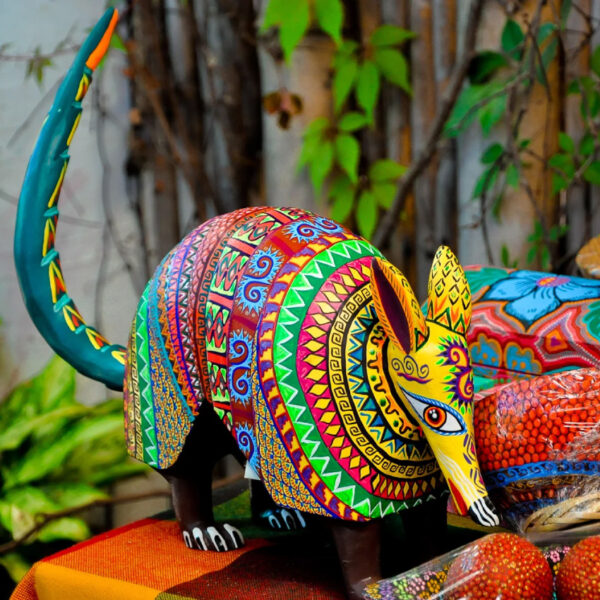
Handicrafts from Oaxaca
Handicrafts from Oaxaca are a great tradition and they offer a diversity that denotes the artistic richness and imagination of its people. The talented artisans of Oaxaca make beautiful pieces of clay, textiles, wood, metal, skins and other materials, forming a rich and varied folk art in both decorative and useful items.… Read More
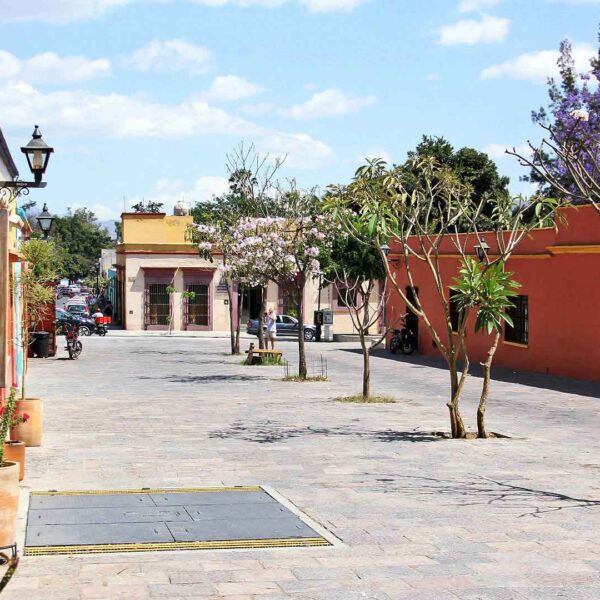
Oaxaca City
Oaxaca is the most diverse state in Mexico. It has peaks that reach more than 3,000 meters high, caverns that are among the deepest in the world, virgin beaches, secluded forests, and sunlit valleys. Oaxaca is rich in traditions and customs and has the largest ethnic population found in Mexico.
The City of Oaxaca, the state capital, is famous for its architecture and for its rich cultural traditions. Oaxaca is also graced by a splendid and varied cuisine and spring-like weather year round. UNESCO declared the city a Cultural Heritage Site.… Read More
Guided Tours in OAXACA
Flights & Hotels in OAXACA
More Tourist Attractions in MEXICO

Archaeological Sites
The Archaeological Zones are the cultural past of every Mexican. You will be amazed at the ambient, nature and the environment that surrounds them. Climbing to the top or being around it will take us back in time to admire every detail. México is a country of culture and traditions, many of which we have inherited from the pre-Hispanic inhabitants of this vast territory, although it is true that there were more settlements in the central and southern part of the country, it is also possible to find some archaeological remains in the north.
… Read More

Ecotourism and Adventure
Mexico is one of the best countries for Ecotourism as it has a great variety of flora and fauna, as well as a large number of refuges for extraordinary species. You can enjoy recreational activities of appreciation and knowledge of nature through contact with it, such as: stargazing, observation of natural attractions, wildlife and bird watching. Throughout México there are more than 176 protected natural areas, 5 of them considered by UNESCO as Natural Heritage of Humanity. Just for this and much more, we believe that Mexico is a Paradise for Ecotourism.… Read More

Capital Cities
Folklore, gastronomy, literary culture, art and exhibitions, is what you will find in the capitals of the states of Mexico. To the north, colonial Mexico, Puebla, Guadalajara, Guanajuato, the Sonoran desert and the California peninsula. To the east Veracruz and the gulf. To the west Acapulco, Oaxaca and Tuxtla Gutiérrez. And to the south the Riviera Maya and the pyramids of Chichén-Itzá, Tulúm and Cobá in Yucatán, Palenque in Chiapas, the cenotes, and the Central American jungles.… Read More

Gastronomy
The Gastronomy of Mexico has a great diversity of typical dishes, which is why it was recognized by UNESCO as Intangible Heritage of Humanity. The basic and representative ingredients of Mexican dishes are: corn, coriander, chili, beans, piloncillo, nopal and tomato. Mexican cuisine is also characterized by its sauces, which serve as an accompaniment to traditional dishes, prepared based on spices.… Read More

Magical Towns
A Magical Town is a place with symbols and legends, towns with history that in many cases have been the scene of transcendent events for our country, they are places that show the national identity in each of its corners, with a magic that emanates from its attractions ; visiting them is an opportunity to discover the charm of Mexico. The Magical Towns Program contributes to revalue a set of populations in the country that have always been in the collective imagination of the nation and that represent fresh and varied alternatives for national and foreign visitors. A town that through time and in the face of modernity, has conserved, valued and defended its historical, cultural and natural heritage; and manifests it in various expressions through its tangible and intangible heritage. A Magical Town is a town that has unique, symbolic attributes, authentic stories, transcendent events, everyday life, which means a great opportunity for tourist use, taking into account the motivations and needs of travelers.… Read More

States Of Mexico
Mexico has an incredible diversity of landscapes, where the beauty of its beaches, internationally recognized, stands out. In its vast territory of coasts, there are beaches of unparalleled beauty, and colorful landscapes. A large network of first-class hotels and tourist services is available to visitors to these beaches. Mexico is also mystical places, dotted with archaeological testimonies inherited from its original inhabitants. Monuments made by the Mayas, Aztecs and Toltecs are located in magical landscapes, like lighthouses in an ocean of natural beauty. They offer visitors buildings that tell their history, and museums that collect their cultural heritage. And that keep alive ancestral traditions, in ceremonies and festivals, where you can enjoy cultural activities and entertainment.… Read More

Traditions in Mexico
It is practically impossible to make a meticulous, and above all, accurate selection of the places to visit in Mexico. Each place that our country houses is unique and beautiful in its own way. Mexico, with its nearly 2 million km², has a large number of scenarios to offer, as well as endless activities to do. Do not lose your way and enter the places to visit in Mexico. In Mexico, apart from the beaches and its famous archaeological sites, there are many other really interesting sites and activities that you should know. In the surroundings of the main cities you will find places full of culture and tradition, where you can spend relaxing, interesting and fun vacations. On your trip through Mexico you cannot stop obtaining souvenirs, the crafts that are made here are of the highest quality and recognized worldwide. A shopping tour cannot be missed.… Read More

Beaches
On the Beaches of Mexico you can immerse yourself in the intense blue ocean of the Pacific bays, sunbathe on the shore of the warm and transparent waves of the Caribbean Sea in Quintana Roo or even rest on the beautiful coasts of the Gulf of Mexico. Mexican beaches hide wonderful secrets for the traveler. By visiting them, in addition to enjoying the excellent climate and water activities, you can discover splendid archaeological sites and interesting colonial cities without traveling long distances.… Read More

